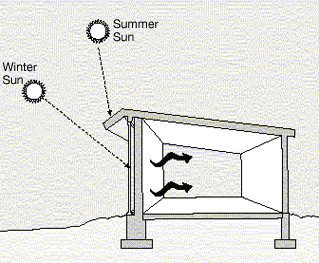Thermal mass

Thermal mass refers to the material inside a building that can help reduce the temperature fluctuations throughout the course of the day; thus reducing the heating and cooling demand of the building itself. Thermal mass materials achieve this effect by absorbing heat during periods of high solar insolation, and releasing heat when the surrounding air begins to cool. When incorporated into passive solar heating and cooling technologies, thermal mass can play a large role in reducing a buildings energy use.
Properties of thermal mass
An ideal material for thermal mass will have:
- high heat capacity
- high material density
Heat capacity of a substance is the amount of heat energy required to change the temperature of an object by a given amount. The SI unit for heat capacity is Joule per Kelvin (J/K). The total amount of energy stored by a thermal mass system is proportional to the size of the system or material, therefore specific heat capacity (J/m2K), heat capacity per unit mass, and volumetric heat capacity (J/m3K), heat capacity per unit of volume, are common metrics used to determine a good thermal mass material.
Thermal mass materials
Listed below is a table of common building materials, their heat capacity, density, and specific heat capacity. As mentioned earlier a good material for thermal mass should have a high volumetric heat capacity.
| Material | Heat Capacity (J/K) | Density (kg/m3) | Volumetric Heat Capacity (MJ/m3K) |
|---|---|---|---|
| Water | 4.18 | 1000 | 4.18 |
| Gypsum | 1.09 | 1602 | 1.746 |
| Air | 1.0035 | 1.204 | 0.0012 |
| Concrete | 0.88 | 2371 | 2.086 |
| Brick | 0.84 | 2301 | 2.018 |
| Limestone | 0.84 | 2611 | 2.193 |
| Granite | 0.79 | 2691 | 2.125 |
| Wood | 0.42 | 550 | 0.231 |
Water has very attractive thermal mass properties, and can be an attractive material for passive solar design; however potential issues with water leakage and damage detour it's widespread use as a thermal mass storage medium. Concrete and brick have relatively high volumetric heat capacity and are common building materials. When used correctly with a solar wall or trombe wall building heating and cooling energy consumption can be greatly reduced.
Phase change materials
Traditional thermal mass materials use sensible heat to store and release passive energy from solar insolation. Phase change materials utilize latent heat storage and can absorb the same amount of solar energy using a much smaller volume of material.[3] As temperature increases, the material changes phases from solid to liquid, this is an endothermic reaction therefore it absorbs heat. When the surroundings cool (at night) the material changes from liquid to solid, an exothermic reaction, releasing the stored heat into the building. The use of phase change materials is a relatively new concept in building science, there are a lot of different materials being used for many different applications.
Thermal mass and climate
During warm weather conditions thermal mass can absorb heat gained from sunlight. This will make the interior space more comfortable, and greatly reduce the cooling demand and cost of air conditioning. During the night as a building cools the stored heat energy is then released into the building interior space reducing the heating demand. Thermal mass is most beneficial in climates where there is a large fluctuation between the daytime, and nighttime ambient temperatures. In areas with high nighttime temperatures thermal mass can still be utilized, the building must then be ventilated at night with the cooler night air to exhaust the stored heat energy.[4]
References
- ↑ Wikimedia Commons. (August 6, 2015). Trombe Wall [Online]. Available: https://upload.wikimedia.org/wikipedia/commons/3/3d/Illust_passive_solar_d2_319pxW.gif
- ↑ Build Green Canada. (August 28, 2015). An explanation of thermal mass [Online]. Available: http://www.buildgreen.ca/2008/09/an-explanation-of-thermal-mass/
- ↑ F. Kuznik, D. David, K. Johannes, and J.-J. Roux, “A review on phase change materials integrated in building walls,” Renew. Sustain. Energy Rev., vol. 15, no. 1, pp. 379–391, Jan. 2011.
- ↑ G. P. Henze, T. H. Le, A. R. Florita, and C. Felsmann, “Sensitivity Analysis of Optimal Building Thermal Mass Control,” J. Sol. Energy Eng., vol. 129, no. 4, p. 473, 2007. 129, no. 4, p. 473, 2007.

